'The Lady in the Van' is a showcase for a great performance by Maggie Smith
Loading...
I’ve never met anybody who doesn’t love Maggie Smith, and if I ever do I’ll run in the other direction. Despite her reputation for playing snippy dowagers á la “Downton Abbey,” she’s capable of playing anything. (If you doubt me, take a look sometime, for starters, at her portrayal of Desdemona opposite Laurence Olivier in “Othello.”) The same emotional insight that allows her to play the high born with such feeling and felicity is continuous with her genius for playing the low born and indigent, as in “The Lonely Passion of Judith Hearne.” Nowhere is this gift more apparent than in “The Lady in the Van,” where she reprises her famed stage performance as Miss Shepherd – a bag lady who carries herself like bedraggled royalty.
Adapted by Alan Bennett from his 1999 play, and directed by frequent collaborator Nicholas Hytner (who also directed the stage version), “The Lady in the Van” is a showcase for what is sometimes generically referred to as a tour de force, which often means a celebrated stage performance that ossified long before it hit the screen. The remarkable thing about Smith in “The Lady in the Van” is that, even though the role is no longer fresh for her, the performance certainly is. She gives it everything she’s got because, you feel, she wants to honor this character. She wants Miss Shepherd to live on.
The movie, which begins in 1970, is billed as “mostly a true story,” which is a bit coy, but this lead-up does invite us to view the drama as a kind of guessing game. Bennett (played by Alex Jennings), a celebrated playwright and sometime actor, first encountered Miss Shepherd when she parked her beat-up yellow van in the driveway of his North London townhouse. Well known to the neighborhood as a roaming, persnickety hag, she found a refuge of sorts with Bennett, who, with a mixture of incredulity and writerly fascination, allowed her to take up residence in his driveway until her death 15 years later.
The film gets at the ways in which writers find themselves conflicted about exploiting the lives of real people in their writing. Bennett in the movie is split into two selves, both played, using camera trickery, by Jennings. His alter ego is his non-writer self, the one who tells his counterpart, “I live, you write, that’s how it works.” At first, Bennett the playwright, who also cares for his aging, demanding mother, resists the temptation to keep a notebook of observations about Miss Shepherd, despite the fact that she is such obvious “material.” He says “she’s just something that’s happening,” but comes to realize that “you don’t put yourself into what you write, you find yourself there.”
But Bennett, who looks a bit like a homebody Elton John and is played with tart wit by Jennings, is much more than a sympathetic, somewhat parasitic helper. He genuinely cares about Miss Shepherd, despite (or because of) her cleanliness issues, which he describes as “her odoriferous concerto.” He’s determined to do her a good turn but not, to his credit, “without thoughts of strangulation.”
If Bennett were nonstop nice he’d be unbelievable and the story would dissolve into sentimental goo. Fortunately, with Smith around, that would not have happened anyway. It would have been a breeze for her to play this lady as some sort of vaudeville crone, with lots of wink-winks to the audience just to let us know she’s only “acting.” But there are emotional layers to this woman that unfold slowly for Bennett, as they do for us. The film, which never treats the homeless as “the other,” is, among other things, a species of detective story.
Why does Miss Shepherd react with such violence when loud music is played within earshot? Why does she claim to get her guidance from the Virgin Mary? When did she learn to speak French? Bennett’s fascination is one with which we can identify whenever we encounter the homeless and imagine what their past lives might have been like. Miss Shepherd does not easily yield up her secrets – it’s a mark of her pride as well as her paranoia.
When she allows herself to let go – when, for example, she blissfully careens down a hill in her wheelchair as if she were riding a magic carpet – we can see how avidly this woman wants to jettison her cares and just have fun. We also see the pain underneath it all, especially in the scene when she is picked up by social services and, showered and housed, is, for a time, rendered startlingly vulnerable. In moments like these, or in the end, when she and Bennett strike a full chord of connection, you can see why Miss Shepherd flounced and caterwauled her way through life. This grande dame was putting on a show to camouflage her fears. In Bennett, she found the ideal protector – and chronicler. Grade: A- (Rated PG-13 for a brief unsettling image.)







